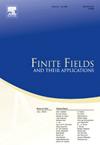(r,δ)-定值q和d的局部可修码的大小界限
IF 1.2
3区 数学
Q1 MATHEMATICS
引用次数: 0
摘要
Erasure code可以增强分布式存储系统的容错性和可靠性。其中,局部可修复编码(lrc)起着至关重要的作用。局部性为r的局部可修复码(称为r- lrc)可以通过访问最多r个其他编码符号来恢复任何编码符号。lrc的原始定义用于修复单个故障节点。为了解决多节点故障的实际问题,Prakash等人(2012)引入了局域性(r,δ)的lrc概念,可以看作是r- lrc的推广。从那时起,(r,δ)- lrc的界和结构得到了广泛的研究。本文研究有限域Fq上具有不相交局部修群的(r,δ)- lrc的界和构造,其中参数r,δ,字母大小q和最小距离d是固定常数,而编码长度n趋于无穷。在经典Gilbert-Varshamov (GV)界方法的启发下,我们首先导出了(r,δ)- lrc的渐近Gilbert-Varshamov型界。我们使用第一和第二矩方法成功地证明了这种gv型边界作为具有不接合的局部修复群的随机线性(r,δ)- lrc的阈值。作为一个推论,这样的随机线性(r,δ)-LRC有很高的概率达到gv型界。作为经典gv型界的类似物,我们提出了(r,δ)- lrc的两种结构,它们都优于该gv型界。一种结构是由外部BCH码和内部[r+δ−1,r] MDS码的直接连接得到的。另一种构造是基于两个矩阵的克罗内克积。为了补充我们的结果,我们还考虑了n很大但有限的情况。在这种情况下,我们为二元r- lrc提供了明确的上限,这是对Ma和Ge(2019)中的上限的改进。此外,对于某些特定参数,该界是紧的。本文章由计算机程序翻译,如有差异,请以英文原文为准。
Bounds on the size of (r,δ)-locally repairable codes for fixed values q and d
Erasure codes can strengthen fault-tolerance and reliability in distributed storage systems. One of these, locally repairable codes (LRCs), plays a crucial role. A locally repairable code with locality r (called r-LRC) can recover any coded symbol by accessing at most r other coded symbols. The original definition of LRCs is used to repair a single failed node. To address the practical concern of multiple node failures, the concept of LRCs with locality was introduced by Prakash et al. (2012) which can be seen as a generalization of r-LRCs. Since then, the bounds and constructions of -LRCs have been extensively studied.
This paper is dedicated to both the bounds and constructions of -LRCs with disjoint local repair groups over a finite field , where the parameters r, δ, the alphabet size q, and the minimum distance d are fixed constants, while the code length n tends to infinity. Inspired by the method of the classical Gilbert-Varshamov (GV) bound, we first derive an asymptotic Gilbert-Varshamov-type bound for -LRCs in this regime. We manage to show that this GV-type bound works as a threshold for random linear -LRCs with disjoint local repair groups using the first and second moment methods. As a corollary, such a random linear -LRC has a high probability of attaining the GV-type bound. As an analogue to the classic GV-type bound, we present two constructions of -LRCs that each beats this GV-type bound. One construction is obtained from a straightforward concatenation of an outer BCH code and an inner MDS code. Another construction is based on the Kronecker product of two matrices. To complement our results, the case that n is large but finite is also considered. In this regime, we provide an explicit upper bound for the binary r-LRCs, which is an improvement over the one in Ma and Ge (2019). Furthermore, this bound is shown to be tight for some specific parameters.
求助全文
通过发布文献求助,成功后即可免费获取论文全文。
去求助
来源期刊
CiteScore
2.00
自引率
20.00%
发文量
133
审稿时长
6-12 weeks
期刊介绍:
Finite Fields and Their Applications is a peer-reviewed technical journal publishing papers in finite field theory as well as in applications of finite fields. As a result of applications in a wide variety of areas, finite fields are increasingly important in several areas of mathematics, including linear and abstract algebra, number theory and algebraic geometry, as well as in computer science, statistics, information theory, and engineering.
For cohesion, and because so many applications rely on various theoretical properties of finite fields, it is essential that there be a core of high-quality papers on theoretical aspects. In addition, since much of the vitality of the area comes from computational problems, the journal publishes papers on computational aspects of finite fields as well as on algorithms and complexity of finite field-related methods.
The journal also publishes papers in various applications including, but not limited to, algebraic coding theory, cryptology, combinatorial design theory, pseudorandom number generation, and linear recurring sequences. There are other areas of application to be included, but the important point is that finite fields play a nontrivial role in the theory, application, or algorithm.

 求助内容:
求助内容: 应助结果提醒方式:
应助结果提醒方式:


